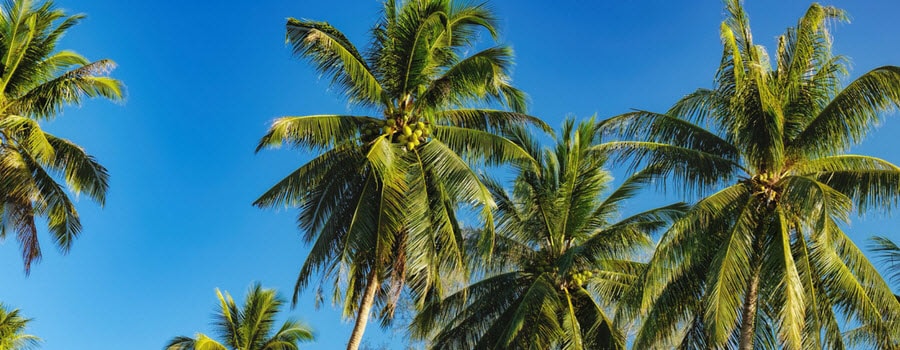Fertilizing Palm Trees
- Milorganite AgronomistDecember 15, 2017
Tropical climates, ocean shorelines, lazy vacations, and sunbathers basking in the sun come to mind when we see palm trees waving in the breeze. It’s a beautiful image, but not entirely accurate. Palm trees grow in climates from tropical to temperate and in the U.S. can be found from Florida to Virginia, Louisiana to Los Angeles. Most people are shocked to learn there are even palm trees thriving on the shores in Vancouver, British Columbia!

Fertilizer Nutrients Critical to Palms
Palm trees require a steady diet of several nutrients and micronutrients, particularly nitrogen (N), potassium (K), magnesium (Mg), manganese (Mn), and iron (Fe). All are critical to the health of palm trees.
The challenge is palms often grow in some of the poorest soils imaginable, including sand, if that can really be considered “soil.” Sandy soil lacks nutrients, as well as organic matter. Palms must be fertilized to remain healthy.
Palms can suffer from a number of conditions based on the nutrients deficient in the soil. The most common nutrient deficiency is potassium, the first signs of which will be some sort of yellowing of older leaves. When fertilizing your palm trees, potassium supplements should accompany the application of Milorganite.
Iron is one nutrient palm trees need to remain green. If you notice an overall lack of green in the palm tree’s leaves, it may be a sign of iron deficiency. Milorganite contains more than 2 percent of non-staining iron, making it a good base for your fertilization program.
Check with your local university extension to learn more about the common nutrient deficiencies in your area and to have your soil tested to identify specific nutrients deficient in your soil.
What Fertilizers NOT to use on palm trees
Don’t use quick-release, manufactured turf fertilizer near palm roots, as this type of fertilizer can cause a nutrient imbalance in the soil. Turfgrass fertilizers are typically high in nitrogen (N) and low in potassium (K). The high level of nitrogen promotes growth that can’t be supported by the low amount of potassium, creating a potassium deficiency that would be worse than if no fertilizer had been applied.
Low-nitrogen, slow-release Milorganite can be used, because it can be safely applied throughout your yard and garden, including your lawn and trees.

When and how much to fertilize your palm tree
When fertilizing palm trees, it’s important to use a slow-release fertilizer, such as Milorganite, which can work for up to 10 weeks, as it provides nutrients over a longer period of time and reduces the risk of leaching. Quick release fertilizer, especially in sandy soil, can easily wash away after only a few rains. Milorganite also contains organic matter, which builds healthier soil and hold moisture.
Apply Milorganite four times annually, evenly scheduled throughout the growing season, which could begin as early as March and end as late as October, depending on your location. Apply 5–10 lbs. of Milorganite by broadcasting it under the entire canopy of the palm. Stay two feet from the trunk of a palm; it’s tender and can be easily scared, or burned when applying quick-release fertilizers.
Fertilizing newly planted palms
You can add the recommended amount of Milorganite when planting container-grown palms by mixing it into the soil at the bottom of the hole. Application rates are determined by the height of the palm: 2 lbs. for 4 feet; 5 lbs. for 10 feet; and, 10 lbs. for 20 feet. Water daily for about 45 days.
Palm trees are a special landscape specimen no matter when they’re found and with proper fertilization, they’ll continue to conjure the feeling of a laid-back lifestyle.
Tips for healthy palms
- Good soil helps keep nutrients and moisture where they belong. Peat moss is a good option. Avoid using soil with added fertilizer.
- When needed, water palms early in the morning or late in the afternoon during the summer, and earlier in the day during the winter months.
- Apply 2 to 6 inches of mulch around the palm, beginning at least 6 inches from the trunk and extending about 2 feet. Use commercial sterilized mulch to help prevent the spread of diseases that could be detrimental to the palm.
- Never puncture or damage the trunk of a palm with nails, screws, or a string weed trimmer. Wounds to palm trunks never heal and makes them more susceptible to disease.

